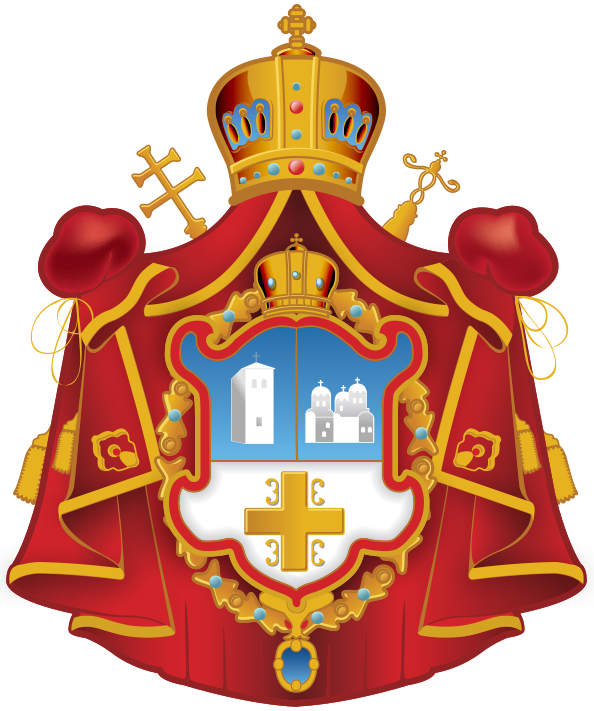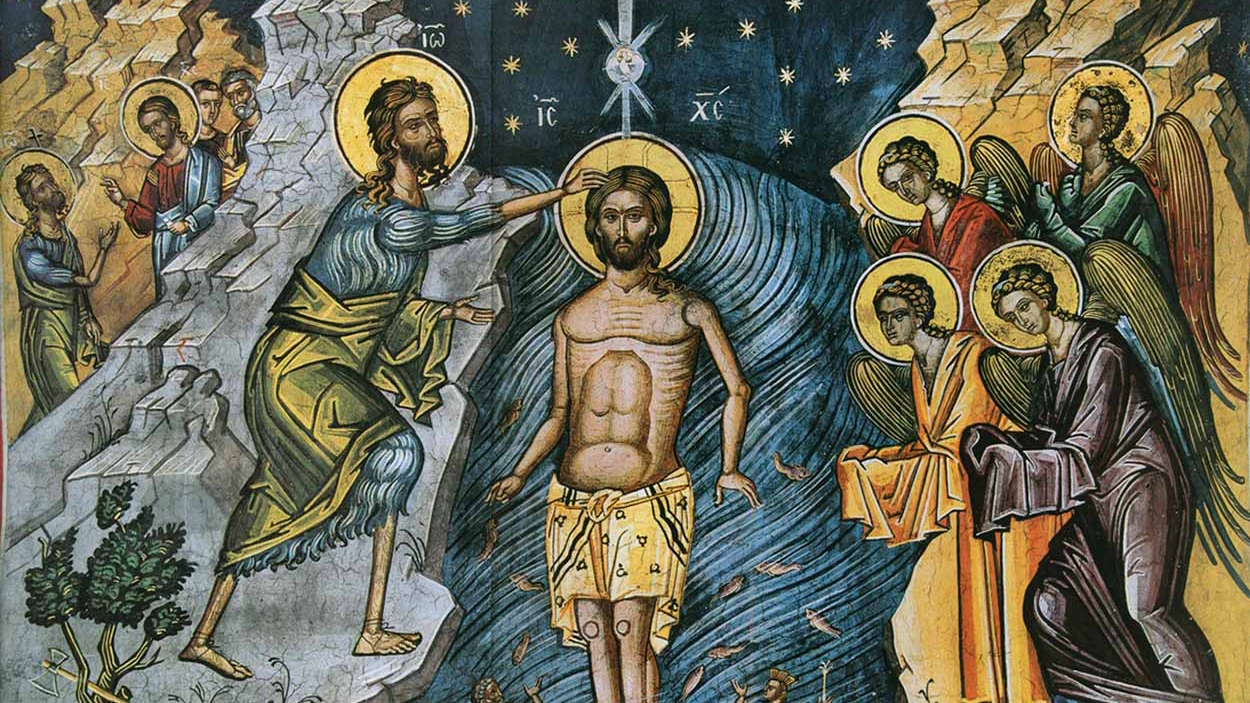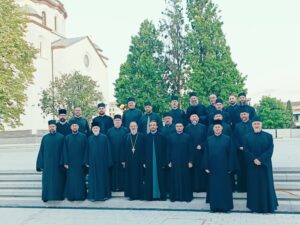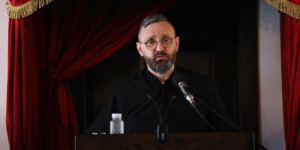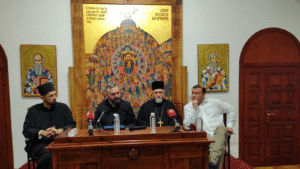And Jesus, when He was baptized, went up straightway out of the water
This passage continues the reflection on the life of the Lord Jesus before His public manifestation to the people of Israel at the Jordan River. The episode from the second chapter of the Gospel of Luke, when the twelve-year-old Jesus is found in the temple, is of particular significance for refuting the fabrications spread for over a century by occultists of various persuasions. These claim that the Lord acquired His teaching and wisdom during travels to India and Tibet, living in Buddhist monasteries and learning hidden wisdom from them. By doing so, they deny His divinity, His redemptive work for the entire human race, and reduce Him to the status of a contemporary guru or sect leader whose teaching contains nothing new, merely copied from the Far East—so admired by the occultists. Given the contemporary relevance of this issue, it is worth citing the insightful reasoning of Saint Nikolaj Velimirović: “Only once during His thirty years of silence did the Lord Jesus speak. At the age of twelve, during the Passover in Jerusalem, He was found in the temple among the teachers and elders, listening and asking questions. And all who heard Him were astonished at His understanding and answers. For three days, His Mother, the Most Holy Virgin Mary, and Joseph searched for Him, and finally found Him in the temple. ‘Why were you looking for Me?’ He said to them. ‘Did you not know that I must be about My Father’s business?’ But they did not understand. And He went down with them and came to Nazareth and was subject to them. And He increased in wisdom and stature and in favor with God and men. Why this interruption of Jesus’ silence at the age of twelve, Theodule? And why this brilliant scene in the temple before the Jewish teachers and elders, if it bore no visible connection to His later mission as a teacher? And why did the Evangelist Luke record it? Because it was the will of God the Father, who cared for His Son Jesus and foresaw the future. The Heavenly Father foresaw that the eternal persecutors and slanderers of His Son would spread lies about Jesus, claiming that He spent His youth in India learning wisdom and miracles from yogis and fakirs. Have you not seen, Theodule, in the enormous slanderous literature against Jesus, books titled: ‘Jesus in India,’ or ‘Jesus among the Indian Yogis,’ or ‘Jesus in Tibet,’ and so on? The aim of the unbelievers and slanderers, in the spirit of Judas, is clear: to prove that Jesus Christ said nothing new, nor did anything original that had not already been said and done in India. Therefore, He is not the Messiah, nor the Savior of the world, nor the incarnate God, but merely a disciple of India and one of countless Indian philosophers and yogis. To refute this in advance, and to prevent Christians from being confused by such fabrications and slanders, by Divine Providence, the twelve-year-old Jesus appeared in the temple in Jerusalem before the Jewish teachers and elders, astounding them all with His wisdom. And again by Divine Providence, Saint Luke recorded this scene in his Gospel. This proves that Jesus, at the age of twelve, was in Nazareth, among His kin and at home, and that even then He was exceedingly wise, not in need of India to teach Him wisdom. Was He not in India before that? That is inconceivable. What would a child under the age of twelve do in India, where children were not even admitted into monasteries? Moreover, Luke’s description makes clear that before the age of twelve, Jesus traveled to Jerusalem every year with His parents for the Passover feast.”
Saint John Chrysostom draws attention to the incomprehensible humility of Christ for us humans: that He, the Lord and Creator, undergoes all this for our sake, in order to save us—Christ was born as a man, lived as a man with all human weaknesses except sin, was circumcised and baptized, and finally suffered the most terrible torments. Chrysostom writes: “With the servants, the Lord; with the guilty, the Judge comes to be baptized. But do not be confused by this: in this humility His exaltation shines forth. For what wonder is it if He accepted baptism and approached a servant along with others—He who for so long condescended to remain in the virgin’s womb, who was born with our nature, received blows and the cross, and endured all that He endured? What is truly wondrous is that He, being God, desired to become man; all else follows from this.” Additionally, Saint Ephraim the Syrian highlights the very fact that the Lord came to be baptized as confirmation of His true human nature—thereby refuting the ancient heretics who claimed He had not taken on human nature.
We continue with the interpretation of the third chapter of the Gospel according to Matthew (verses 14 and 15):
But John tried to prevent Him, saying: “I need to be baptized by You, and do You come to me?” But Jesus answered and said to him: “Let it be so now; for thus it is fitting for us to fulfill all righteousness.” Then he allowed Him.
The Holy Fathers explain the reasons for the baptism of the Lord. Jesus Christ could certainly have begun His public ministry without being baptized in the Jordan, as He was without sin. Blessed Jerome of Stridon offers the following explanation: “There are three reasons why the Savior received baptism from John. First, because He was born as a man, He wished to fulfill all righteousness and show humility before the Law. Secondly, in being baptized by John, He confirmed the value and importance of John’s baptism. And thirdly, by sanctifying the waters of the Jordan, He signified the coming of the Holy Spirit during the baptism of believers, manifested through the descent of the dove.” Blessed Theophylact of Ohrid explains John’s words “I need to be baptized by You” as coming from the awareness of his descent from Adam. He writes, “The Forerunner had need to be cleansed by the Lord, since he too, as a descendant of Adam, was tainted by the uncleanness of disobedience. And Christ, having taken on flesh, cleansed all.”
Saint John Chrysostom beautifully describes how the Lord Jesus pacified the soul of John the Forerunner, who was shocked at Christ’s intention to be baptized: “Since John’s baptism was a baptism of repentance and was intended to bring people to awareness of their sins, in order to prevent anyone from thinking that Jesus was coming with such a purpose, John called Him the Lamb and the Redeemer of the world. He who could remove the sins of the entire human race was certainly without sin Himself. Therefore, John did not say, ‘Behold the Sinless One,’ but something far more significant: ‘Who takes away the sin of the world’—so that, having believed this, you would understand that He came to baptism for another reason. That is why John said to Christ, who approached him: ‘I need to be baptized by You, and do You come to me?’ He did not say, ‘Do You wish to be baptized by me?’—he did not even dare to phrase it that way. What did he say? ‘Do You come to me?’ And what does Christ do? Here again He acts as He would later with Peter. When Peter tried to prevent the washing of his feet, he heard, ‘What I am doing you do not understand now, but afterwards you will understand,’ and ‘You have no part with Me’ (John 13:7–8). In a similar way, John, having heard: ‘Let it be so now, for thus it is fitting for us to fulfill all righteousness’ (Matt. 3:15), immediately obeyed. Neither Peter nor John were stubborn; both demonstrated love and obedience, and did everything to submit to the Lord. Notice how Jesus persuades John with the very thing that troubled him. He does not say that justice demands it, but ‘it is fitting.’ Nor does He simply say, ‘Let it be,’ but adds, ‘now.’ In other words, it will not always be this way—He implies that the time will come when John will see Him in the state in which he longs to see Him; for now, he must wait.”
Now we come to the final verses of the third chapter, which describe the Theophany:
And Jesus, when He was baptized, went up immediately from the water; and behold, the heavens were opened to Him, and He saw the Spirit of God descending like a dove and coming upon Him. And behold, a voice from heaven said: “This is My beloved Son, in whom I am well pleased.”
The Holy Fathers have provided rich and profound interpretations of these verses, which describe the manifestation of the Holy Trinity to the human race. Saint Gregory Palamas states that Christ’s immersion in the water symbolically represents His descent into Hades, and His rising from the water signifies His Resurrection.
Saint Nikolai of Ohrid draws attention to events from the Old Testament and connects them with Christ’s baptism, revealing the essential significance of the Sacrament of Baptism—that the Holy Spirit descends upon a person only after baptism. Saint Nikolaj writes: “Christ is immersed in the water, not to cleanse Himself, but to symbolically drown the old man. Through His immersion in the water, He reenacts the flood of the world in the time of Noah, and the drowning of Pharaoh and his Egyptian army in the Red Sea. In the universal flood, sinful humanity was drowned; in the Red Sea, Pharaoh, the enemy of the living God, was drowned. Christ took upon Himself the sins of men. Voluntarily, He agreed to be drowned in place of sinful humanity; voluntarily, He accepted the fate of the drowned Pharaoh, the enemy of the living God. He immerses His body in the water as though He were burying it in a grave. He is submerged for a moment and then rises and emerges from the water… The Spirit did not descend upon Christ while He was submerged in the water, but when He emerged from it. In this way, the Wisdom of God teaches us that the Spirit of God does not descend upon the old man—who is alive to sin and dead to God—but only upon one who is reborn, spiritually regenerated, who has died to sin and become alive to God.”
The Holy Fathers also reflected on why the Holy Spirit appeared in the form of a dove. Saint John Chrysostom writes: “Why did the Holy Spirit appear in the form of a dove? Because the dove is a meek and pure creature. And just as the Holy Spirit is the Spirit of meekness, He appeared in that form. Furthermore, this recalls antiquity. When the universal flood overwhelmed the whole world and our race faced extinction, that bird appeared and brought a sign of the end of the flood, bringing back an olive branch and announcing peace across the world. All this was a foreshadowing of what was to come. At that time, people were in a dire state and deserving of even greater punishment. So, that you might not despair, Scripture reminds you of this event. Even then, despite the hopeless state of affairs, there was deliverance and restoration: then through punishment, now through grace and an ineffable gift. Therefore, no dove appears with an olive branch, but instead One is revealed who liberates us from all evil and gives good hope. He does not merely bring man out of the ark, but raises the whole universe to heaven, and instead of an olive branch brings the adoption of the whole human race.”
It must be said that some in antiquity were scandalized by the fact that the Holy Spirit appeared in the form of a dove and assumed that the Holy Spirit was therefore in a subordinate position to the Lord Jesus Christ, since Jesus appeared to humanity as a man. Saint John Chrysostom responds to this misconception: “I have heard some say that the difference between Christ and the Holy Spirit is like that between a man and a dove, because He appeared in human nature, while the Spirit appeared in the form of a dove. What shall we say to this? That the Son of God took on human nature, but the Holy Spirit did not take on the nature of a dove. That is why the Evangelist did not say ‘in the nature of a dove,’ but ‘like a dove.’ And this was a unique occurrence; the Spirit had never before appeared in this manner. Moreover, if you think that this implies inferiority, then even the cherubim would be greater than the Spirit to the extent that an eagle surpasses a dove, since they appeared as eagles. Likewise, angels would be superior too, for they often appeared in human form. Let it not be so—by no means!”
Saint Nikolai of Ohrid writes about the immense greatness of this event for the human race: “The heavens opened, the Spirit in the form of a dove—and behold, a voice from heaven! Christ’s baptism was so significant that not only angels appeared, but the Holy Trinity itself was revealed: the Father, the Son, and the Holy Spirit; the Father through the voice from heaven, the Spirit in the form of a dove, and the Son as the new and perfect Man, the God-man. ‘This is My beloved Son, in whom I am well pleased!’ With these words, God the Father proclaims His Son Jesus. These words echo the angel Gabriel’s message to the Most Holy Virgin Mary: ‘He will be called the Son of the Most High’ (Luke 1:32), and also, ‘He will be called the Son of God’ (Luke 1:35). Now, God the Father truly names Him His beloved Son. For Christ is the only-begotten Son of God by birth in eternity and the only-begotten Son of God by birth in time. God the Father does not call all people His sons, but only Christ. All others may be called sons of God by adoption—and that through Christ and in His name. When Christ later says to men, ‘You have one Father, who is in heaven,’ He means that men are sons of God only by adoption. It is only the boundless love of God that allows Him to call His creatures sons. But Christ alone is the true and only Son of God—by love and by essence. Hence it is said, ‘My beloved Son, in whom I am well pleased.’ These two statements amplify the expression of the Father’s love and approval toward His Son. The eternal bond between the Father and the Son was not weakened, nor was their mutual love diminished by the Son’s descent into the sinful world and His taking on of weak human flesh. Thus, Christ’s baptism in the Jordan is inseparably connected with the revelation of the Holy Trinity to mankind. There is no greater revelation than this. For in it is made known the mystery of the Triune being of God.”
Adapted and composed for the modern reader based on patristic commentaries by: Stanoje Stanković
